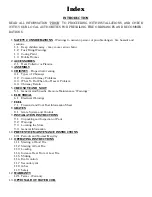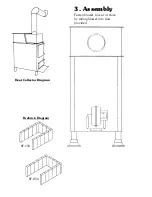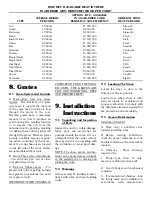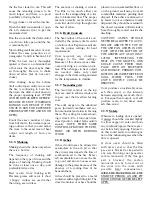
7
The most common cause of poor
draft is an improperly sized flue
liner. We recommend that the chim-
ney liner’s inside dimensions be at
least as large as the appliance’s col-
lar size and no larger than 125% of
the collar for a round flue. For
instance, an 8" furnace collar is 50
square inches; increased by 25"%
would be 63 square inches, or
approximately a 9" round flue. In
general for round liners we recom-
mend that they not be increased
more than 1" from that of the
Harman’s collar size. The reason for
the above is that Harman appli-
ances are designed to produce the
maximum amount of heat per
amount of fuel burned. A a result,
the flue gas temperature is lower
than for some similar equipment.
TO SUMMARIZE, A HEAT I N G
UNIT CAN PERFORM ONLY AS
WELL AS ITS VENTING SYSTEM
WILL ALLOW IT.
5. Creosote
and Soot
5.1 General and Specific
C reosote Maintenance
Wa rn i n g s
One of the most critical aspects of
operating a woodburning stove is
the control of creosote and soot.
This is especially important when
there is a low demand for heat, such
as in the fall or spring. A good
understanding of the causes and
cures for excess creosote or soot
formation is essential to the opera-
tion of the stove.
Your stove and for that matter, all
types and makes of woodburning
equipment will give trouble with cre-
osote deposits under certain condi-
tions. You should be aware of these
conditions and avoid them.
When wood is burned slowly, it pro-
duces acetic and other pyroligneous
acids that combine with expelled
moisture to form creosote. Highly
combustible in its solid and semi-liq-
uid states, creosote is present in the
gases given off by burning wood.
Creosote may build to a consider-
able thickness on the interior sur-
face of the chimney and stove pipe
subsequently reducing draft. A
SERIOUS FIRE MAY BE IGNITED
IF A SUFFICIENT CREOSOTE
BUILDUP IS PERMITTED.
Creosote condenses from the flue
gases more quickly when the tem-
perature of those gases is low. The
actual amount of creosote deposited
depends on (1) the amount of mois-
ture in the flue gases, (2) the tem-
perature of the stack, (3) the rate at
which the wood is burned, (4) the
amount of draft in the stack, and (5)
how completely the combustible ele-
ments in the flue gases have been
burned in the combustion chamber.
Most problems with creosote are
due to insufficiently dry wood, poor
chimneys with low draft and cold
walls, and/or a low rate of burning
when little heat is required during
the spring and fall months.
Moisture in the Flue Gases May Be
Controlled by:
A. Using properly seasoned fire-
wood.
B. Mixing small pieces with every
full load.
C. Never using only large (usually
less dry) wood during mild weather
when combustion is relatively slow.
The Temperature in the Stack May
be Controlled by:
A. Using as short a length of
stovepipe as possible between the
stove and the chimney.
B. Using an insulated flue pipe to
connect the stove to the chimney.
The Amount of Draft in the Stack
May be controlled by:
A . Having as few bends as possible.
B. Insuring adequate chimney
height and preventing air leaks.
C. Eliminating external obstruc-
tions in the chimney outlet.
D. Having only one appliance per
flue.
C A U T I O N ! O W N E R ’ S
R E S P O N S I B I L I T Y
YOU MUST CHECK YOUR
CHIMNEY FLUE PIPE CONNEC-
TOR FREQUENTLY WHEN FIRST
STARTING TO BURN WOOD TO
DETERMINE THE AMOUNT OF
CHIMNEY MAINTENANCE (CLEAN-
ING) THAT WILL BE REQUIRED.
THIS OF COURSE, IS ALSO
DEPENDENT ON WOOD TYPE,
MOISTURE, AND IN GENERAL,
HOW THE STOVE IS USED.
The chimney connector and chim-
ney should be inspected at least
twice monthly during the heating
season to determine if a creosote
Содержание SF-150 SF-250
Страница 18: ...17...





































